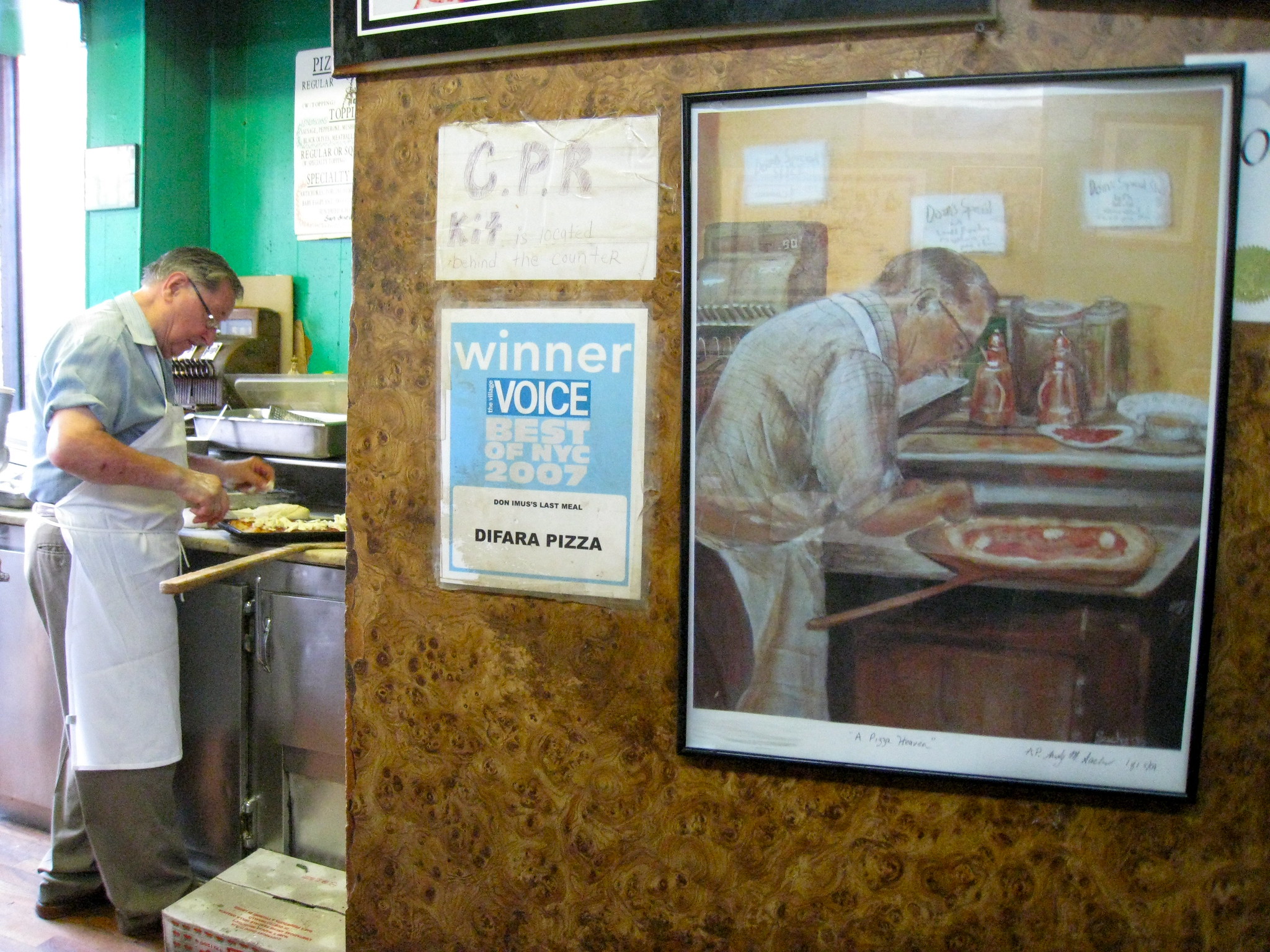This post originally appeared in July 2009 on SliceNY.com, which was the pizza blog I founded in 2003, that was later purchased by Serious Eats (2007), and was then published as a vertical there until 2014, when SE folded up all its sub-sites into the main publication. In 2021 Serious Eats erased a huge swath of early food web history when new ownership scrubbed what was apparently to them low-performing and irrelevant content. In light of Dom DeMarco Sr.'s death on March 17, 2022, I've salvaged what I could of this post from the Wayback Machine and present it here. A couple years ago, I wrote a Di Fara update on my then–pizza blog, Famous Original Slice (which I'm in the process of migrating to this URL). You can find that piece here: Hello, Di Fara. It’s been a while…
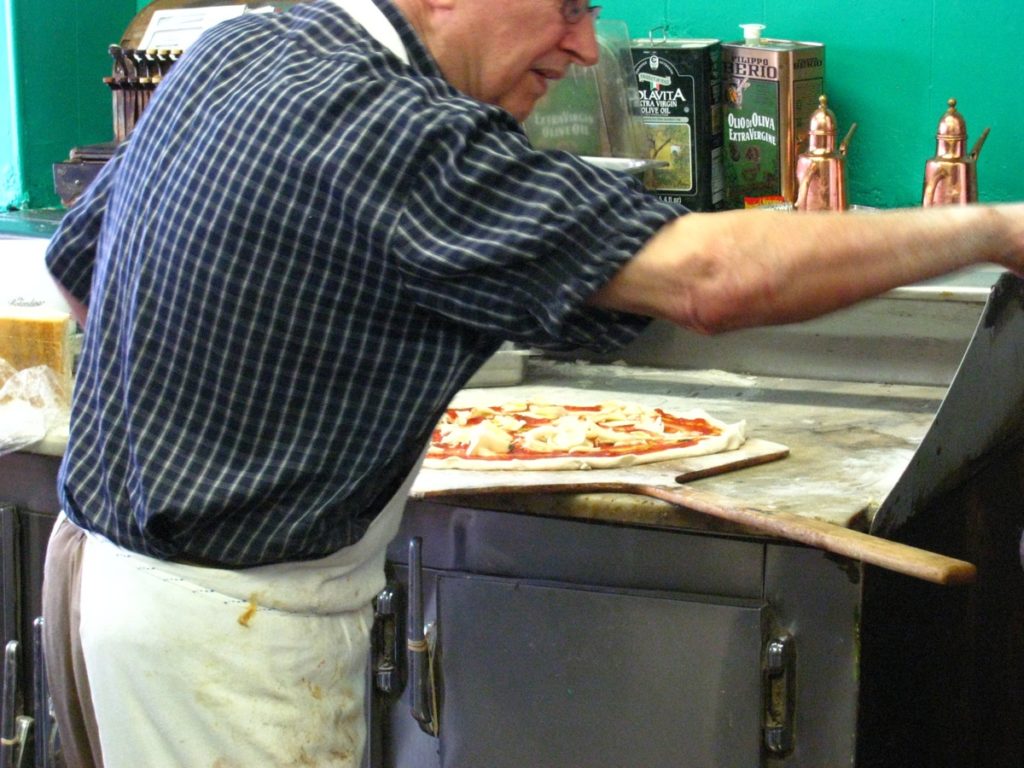
Now that the $5 Di Fara slice has hit the New York Times, I’ve got friends and strangers emailing and twitting me with questions I feel I’ve answered a million times here on Slice—albeit over the span of many different blog posts. So, as a public service, here is all the info you need to know about Di Fara gathered in one place—a Di Fara FAQ, if you will.
What’s So Great About It?
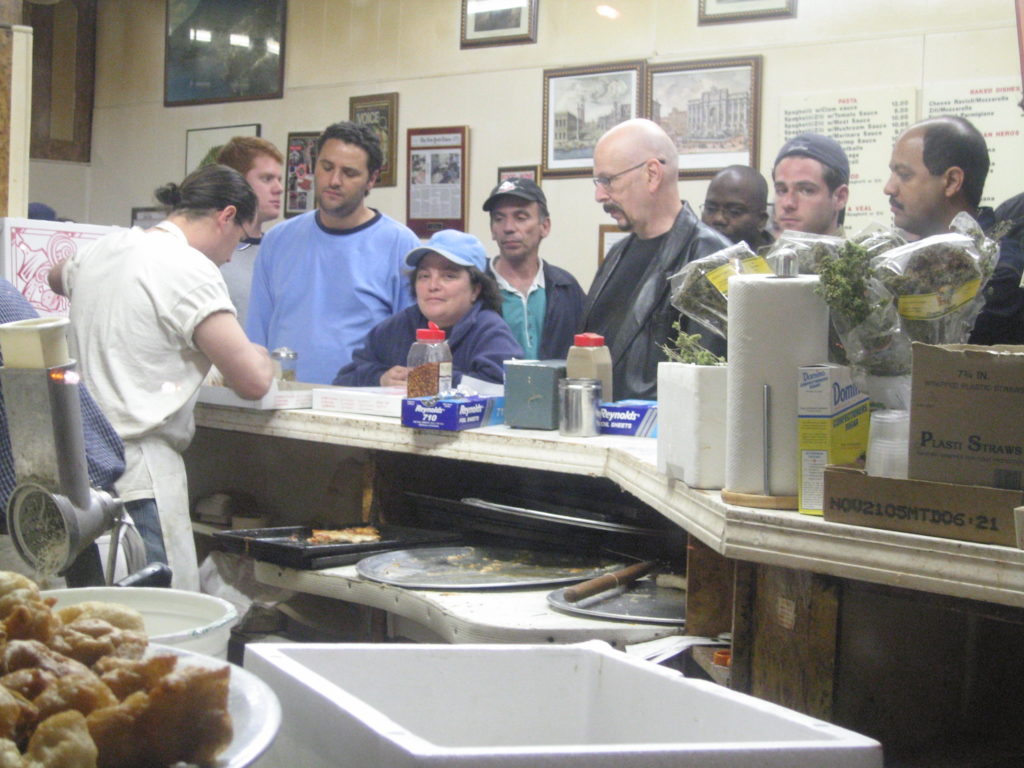
Do I really have to rehash all this? A pie from Di Fara can be transcendent when proprietor Dom DeMarco‘s at the top of his game. If you’re a New Yorker, all I have to tell you is that there’s a really fucking long line for it. Isn’t that enough? If you’re not a New Yorker, you wouldn’t understand.
If you’re not into pizza, don’t bother. If you are a pizza freak, you NEED to go just to see for yourself.
Is It Really Worth $5 a Slice?
Some lady in the New York Post:
They must be out of their minds. It would have to be the best slice of pizza in the world,” said Phyllis Turim of Brooklyn, who doesn’t plan to find out for herself.
Good. It’ll keep the line a little shorter. But seriously, this is a question you have to answer for yourself. Personally, if I could stand the line and lived in the neighborhood, I couldn’t afford to eat there more than a couple times a week. But if you treat it as a once-in-a-while thing, what’s the big deal?
Quit Hedging. Again: Is It Really Worth $5 a Slice?
OK, OK. It’s not! Lemme qualify that, though …
At $5 a slice, a a whole pie (8 slices) would cost $40. But the whole-pie price is $25, a 37.5% discount. So do the math, genius. You don’t have to be Suze Orman to recognize the better deal here.
And, honestly, going with a whole pie is your best bet. If the “volume discount” isn’t enough motivation for you, just know that Dom is pretty bad about keeping by-the-slice pies around very long. If he doesn’t have one on the counter, you’re better off ordering a bespoke pie.
When’s the Best Time to Go?
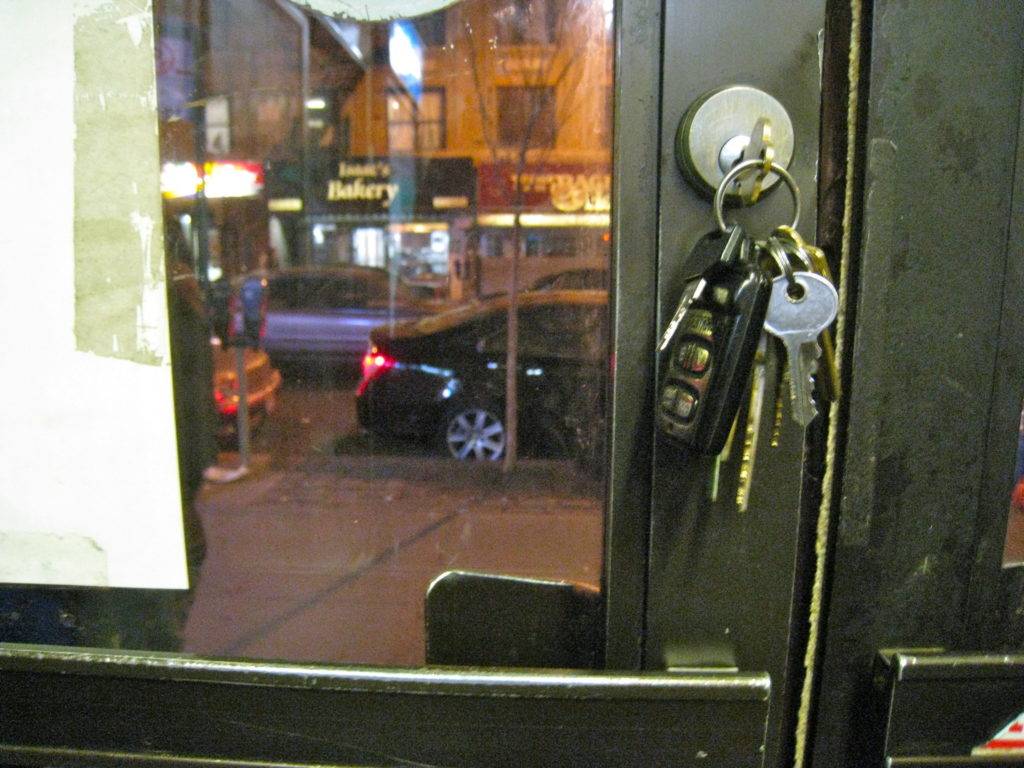
On a weekday, just as it opens at noon. In fact, get there a little early. You might be one of 15 people instead of 30 or more. Friend of Slice Karol Sheinen also recommends going in the rain. Seems to keep the less hearty away.
Other than that, you’re out of luck. There is almost no ideal time to go anymore. You’re always going to run into a crowd.
Don’t go: On Monday or Tuesday. It’s closed. Or between the hours of 4:30 p.m. to 6 p.m.; it’s closed for a break.
Be Sure To: Get there at least a half hour before the end of the lunch or dinner service. Dom closes the door around 4 p.m. and 8:30 p.m., respectively. Whoever’s in the shop gets served. Whoever’s late, gets locked out.
How Long’s the Wait?
Hard to say. if you get there at a miraculously light time (see above), you might only wait a half hour. But wait times of up to two hours or more are not unheard of.
Seriously?
Absofugginlutely.
Do You Have Any Strategies?
Don’t go there hungry. Seems counterintuitive, don’t it? If you think you’re going to be eating anytime soon after you arrive, you’re sadly mistaken (see above). Eat a light snack before you get on the train or in your car. Bring some snacks with you.
Don’t order and then sit down. It seems best to remain in Dom’s or his kids’ field of vision so they don’t drop your order. Go with one or two other people—have one order and another try to snake a table for you. (But good luck; there aren’t that many seats.)
Hold your ground. The neighborhood locals and native New Yorkers are brazenly aggressive in ordering and getting what they want. If you’re a meek Midwestern transplant from Park Slope, now is the time to channel your inner asshole and push to the front and beat people down who try to cut the “line.”
There is no “line.” It’s like a bar and Dom (or one of his kids) is the bartender. You’ve got to keep track of who was already bellied-up when you arrived and who came in after you. Don’t let a latecomer nudge ahead (see above).
What’s the Thing to Order?
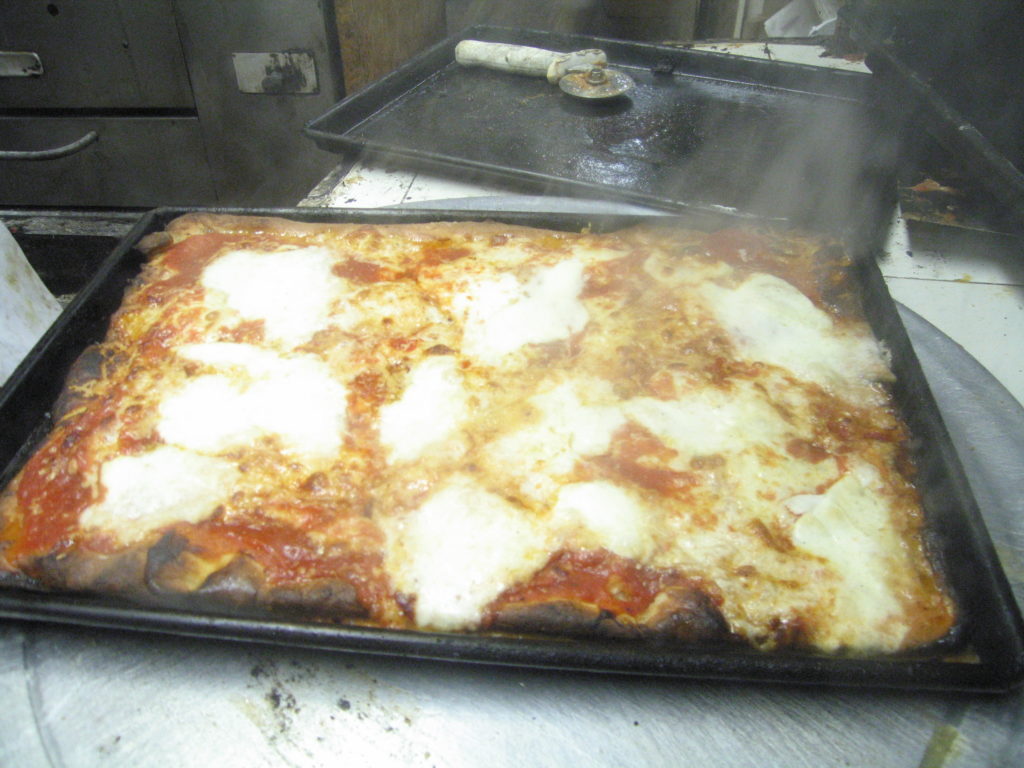
What, do I gotta hold your goddam hand? What the hell do you normally order on a pizza? Then get that. Geeze. Of course, if what you like is “half pepperoni, sun dried tomatoes, onions and half sausage, sun dried peppers, onions,” maybe I do have to hold your hand.
Seriously, though, if it’s your first time, you really can’t go wrong with a plain regular pie or a plain square pie. When I started going, the plain regular (round) pie was the thing to get, but at some point a couple years ago, people started saying that the square was the thing. Personally, I prefer the round to the square, but it’s a mixed bag. Go with some friends and get both, why doncha?
What About the Special Pies?
IMHO, I’d go with a plain if it’s your first time there. You really have to taste how the three-cheese mix, the sauce, and the crust play against each other. Once you’ve got a feeling for it, step it up to the artichoke pie or broccoli rabe if you like.
Does He Really Grow the Basil in the Window?
No! This is a myth that needs debunking. I think even Slice has disseminated this misinfo at one point. Dom does not grow the basil he uses in his window. At one point—maybe even still—he grew rosemary in the window, but he did not use that on the pies. Think about it, dumbasses. How could he possibly grow that much basil in the window?
Any Other Tips?
BYOB: You can bring your own wine or beer. It’s a nice way to pass the time with friends while you wait.
The Di Fara Time Line
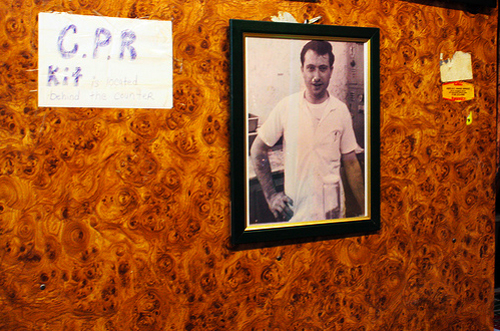
1959: Domenico DeMarco starts making pizza in Brooklyn with his brother at a place in Sunset Park, but, according to a 2004 profile on DeMarco in the Times:
The neighborhood, it was mostly Irish. I wasn’t happy over there. The people were cheap. If you raised it a nickel, they made a big deal out of that. [Sound familiar? —Ed.] There were a lot of break-ins, a lot of broken windows. I got a gun pointed at me one time….
1964: Tired of the Sunset park location, DeMarco moves to the current Midwood, Brooklyn, location—1424 Avenue J—and has been there since.
He started Di Fara not with the brother he mentions but with a partner whose last name was Farina. Di Fara is a combination of Demarco and Farina.
1977: Dom buys out partner but “didn’t bother changing” the name.
Since then, DeMarco has made each pie himself. Even though he has four children that I know of who work in the shop—two daughters, two sons—they play a supporting role and as far as anyone has seen, Dom is the only one to ever touch the pies. The pizza is the product of a singular vision and each pie stands or falls on Dom’s work alone.
The place marches along in obscurity but is a neighborhood fave (at least according to emails I’ve gotten from folks who grew up in Midwood). Steadily, though, pizza connoisseurs outside the neighborhood get wind of the place, and …
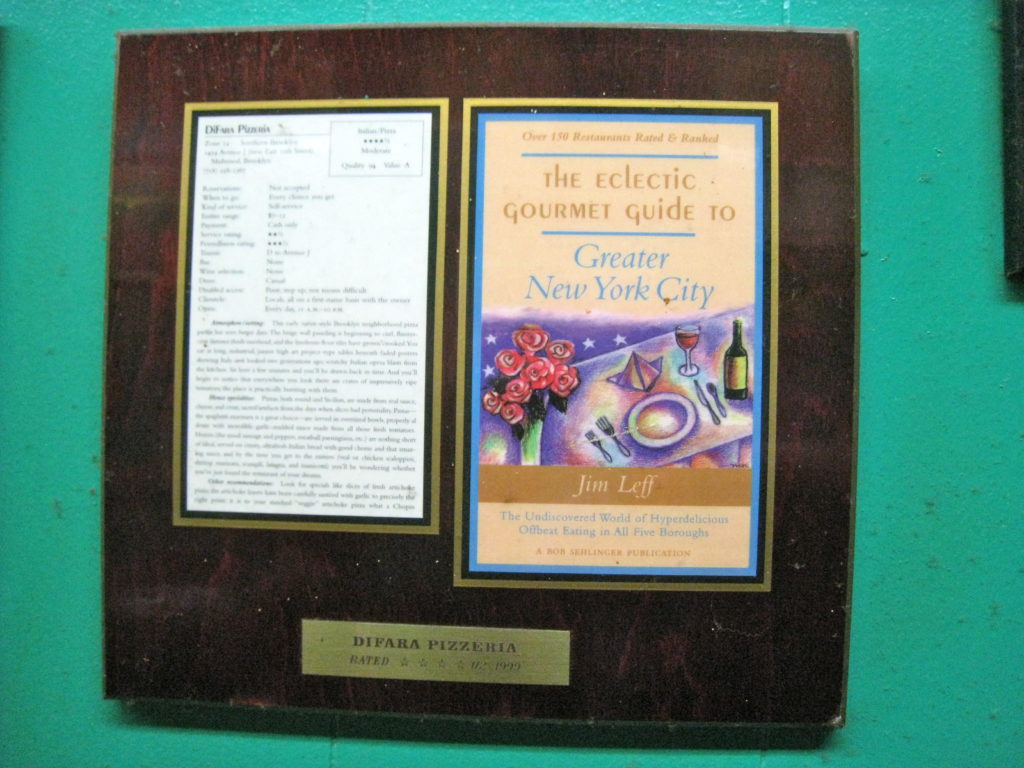
1998: Chowhound founder Jim Leff releases The Eclectic Gourmet Guide to Greater New York City with a write-up of Di Fara. Non-Midwooders (aka “pizza tourists”) start making the trek, but the crowds are still relatively manageable—even though it is a favorite on the popular Chowhound boards.
Early 2001: My friend Seltzerboy* introduces me to Di Fara. (I include this date only so you know that all notes past this point now include firsthand observation.) At this point, the only accolades on Dom’s wall is the laminated plaque bearing Leff’s review.
November 21, 2001: Eric Asimov unleashes the hordes upon Di Fara when he writes it up in the New York Times “$25 and Under” column.
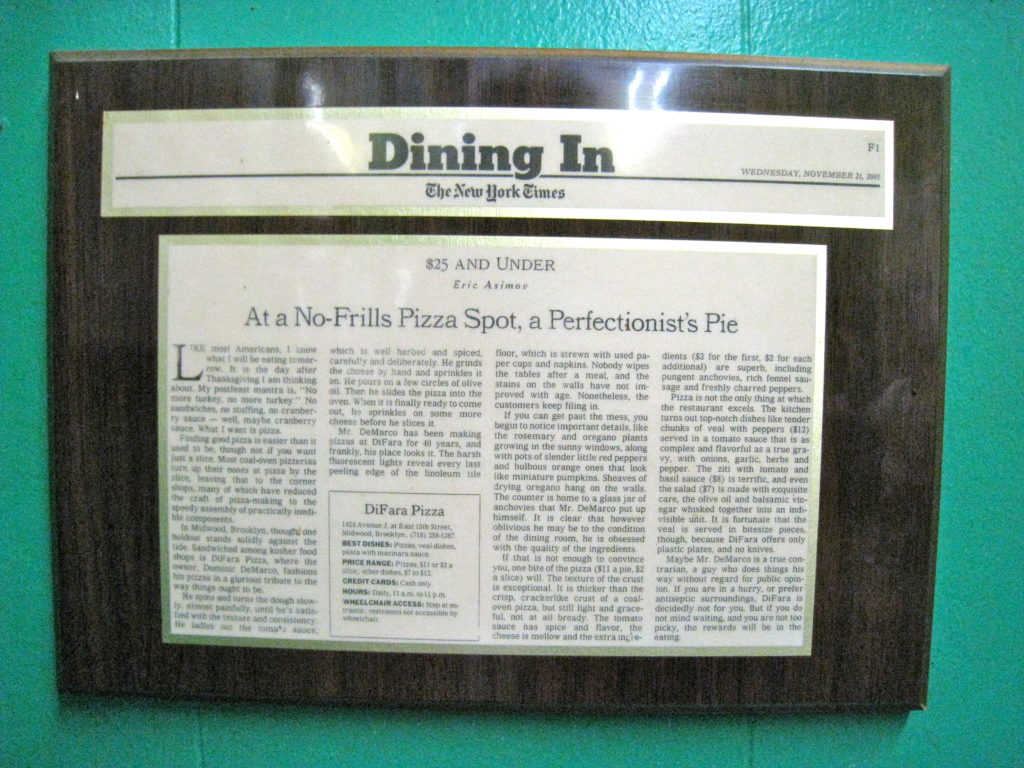
The Asimov piece is laminated, put on a plaque, and hung on the wall near the Leff plaque. In the ensuing years, Seltzerboy and I watch as the press mentions seem to multiply exponentially on the walls, joining the various framed pictures of rural Italian life and the bullhorns. Today, there’s barely room for any more press clippings.
October 13, 2003: Slice is founded and joins the Di Fara acolytes. First Slice mention of Di Fara on October 22, 2003.**
April 2004: The shop closes for a week to remodel, replacing the worn linoleum, putting in a second trash can, tiling the counter, and painting the walls—from beige to the now familiar dark green.
June 2004: Dom appears on the cover of the Village Voice‘s “100 Best Italian Restaurants” issue. This marks the first time, in my memory, that Dom’s picture is splashed across a major publication.
July 2004: Jeff Van Dam writes a beautiful profile of Dom for the New York Times in which DeMarco expounds on his pizza philosophy. “I do this as an art,” DeMarco says.
March 2006: Di Fara closes for a week so Dom can have minor foot surgery. While I’m sure that Di Fara closed for minor emergencies in the pre-blog era, this marks the first time we see the phenomenon of the blogoblabbosphere’s breathless reports on every single bit of news about Di Fara, no matter how insignificant. (And, yes, I know I am just as guilty as the next food blogger on this.)
April 2006: Previously open 7 days a week, the place starts closing on Mondays.
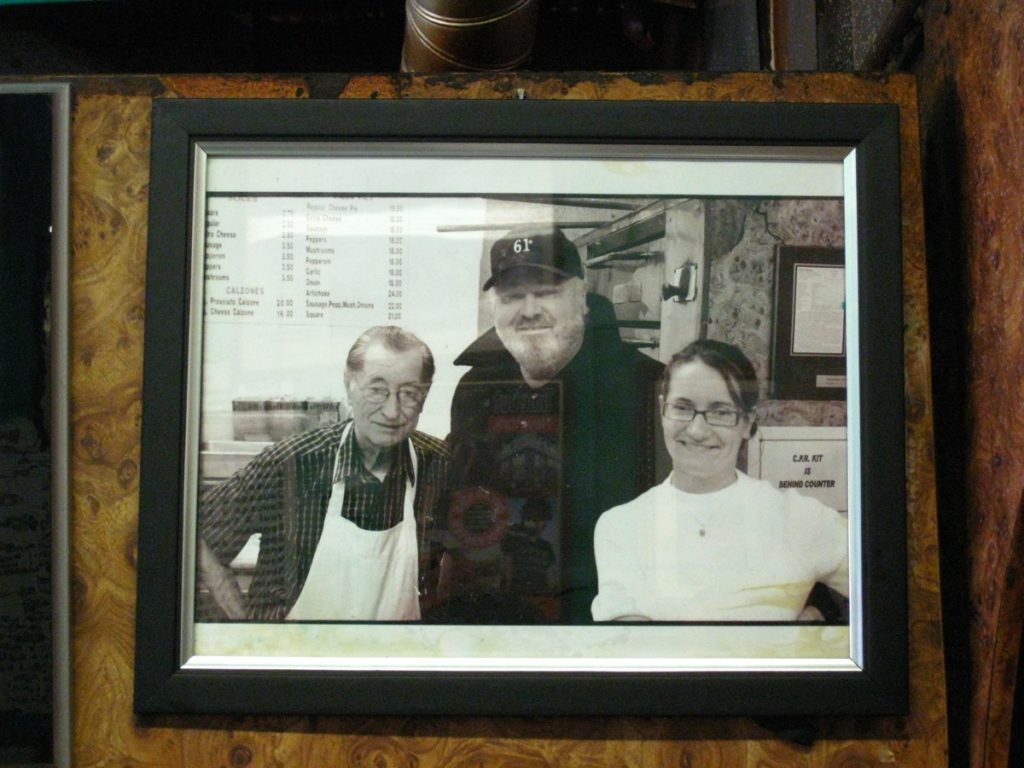
June 2006: Celebrities start coming out of the Di Fara-love closet, with David Blaine as the first. The Yeah Yeah Yeahs’ Brian Chase is another—and so is Kevin Spacey, who’s an alleged pie thief.
March 2007: The first of a few run-ins with the NYC Department of Health closes Di Fara. In April, it reopens.
April 2007: Someone writes a song about Dom.
June 2007: DOH’d again.
February 2008: Slices go up to $4.
July 2008: The Di Fara backlash begins with Gotham City Insider saying “F Di Fara!“
January 2009: Dom breaks his knee cap; Di Fara closes for a couple weeks.
March 2009: DeMarco inducted into pizza hall of fame.
July 2009: Plain slices go up to to $5, and Dom starts closing on Tuesdays in addition to Mondays.
August 1, 2009: The truth must out. Renown food writer Jeffrey Steingarten takes me to task in the very comments of this post.*** An interesting and well-thought-out critique of Slice’s Di Fara mania and Di Fara’s pizza itself (which Steingarten finds banal).
And, a reminder: Here's that Di Fara update I wrote on my then–pizza blog, Famous Original Slice: Hello, Di Fara. It’s been a while…
* SliceNY.com's original "City Editor"—we both came from newspaper backgrounds and liked to joke that Slice was the NY Times of pizza, so we gave ourselves titles parallel to those at a daily paper. ** If you click through that link (which leads to the Wayback Machine version of the original post) and you're on the younger end, you're probably perplexed as to how that constitutes "content." Kids, that's what blogs did in the days before social media. Now, we share links and news via Twitter, Facebook and Instagram stories—and even as voiceover/green screen posts on TikTok. But before that, people turned to blogs and bloggers to help navigate a topic. Bloggers would point to a link, excerpt/copy-paste the relevant/interesting bits, then give their "take" on it. (Heck, this was before we knew to call what we were doing "takes.") *** You'll have to click through to the Wayback Machine version of this to read the comments. Since this reference may be confusing, I'll explain. After I published the initial version of this post on SliceNY.com/Serious Eats in July 2009, food writer Jeffrey Steingarten showed up in the comments and got on me about hyping Di Fara. Just know that there is a contingent of food writers, food lovers, and pizza aficionados who do not like Di Fara. And, to be honest, they do make good points. During the late 2000s, the place went through a very, very rocky period where Dom Sr. was having a hard time keeping up with demand. During which, I have it on good authority, he was making and quickly proofing dough the same day to keep up. (Pizza dough is best when given the proper time to ferment and not rushed.) Pizzas in those days were wildly inconsistent, often burned to a crisp in places and sadly pale and nearly white in others, a visual cue that they were underfermented.
